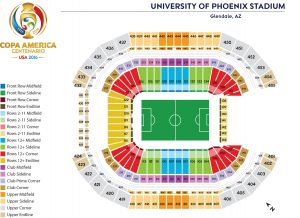By Jed Stone
Financial Accessibility Amongst Fans
Many would argue that soccer is a game of the people. And that is true so long as those in power keep it financially possible. Just this year, UEFA announced a 14% hike in ticket prices to the Champions League Final.[1] When one considers a year-to-year hike in prices for almost anything, a slight but stable increase is usually well understood. However, a jump like this in price to watch one of the most popular sporting events in Europe seems to take the game away from the people. Soccer can easily become about money[2] and marketing the game to the few who can afford it. However, that is not how soccer became a worldwide phenomenon, and it is certainly not the way to sustain it.
In light of this price increase, what is most concerning is the similarity in pricing at the Copa America. While one may see a Champions League final match for as little as $80 in Milan, you could hardly beat that price in the Copa America. One of the cheapest tickets on the market currently goes for $65 to watch Haiti take on Ecuador in New Jersey this summer.[3] If we jump to the average cost for a ticket across all 10 venues for this summer’s Copa America, one might struggle to understand how fans could possible afford to catch this year’s tournament. The average pass across all 10 venues rings up to a monster $888.45.[4]
Sometimes understanding ticket prices can be convoluted, though. In reality, few tickets are released at excessively high prices initially, and then the resale market opens in which a more natural supply and demand economy sets forth. For instance, many of the prices listed above are actually tickets on the resale market, representing a more accurate account of how much one could expect to pay to see a game. As a case study, we can examine how much a Duke student paid to watch the World Cup in 2014 in Brazil in hopes of contextualizing the above prices. According to this student, in order to get tickets to the World Cup, you apply to a lottery. Those who are lucky get tickets, and once you win this lottery, you have the option to buy Tier 1, 2, or 3 tickets. Tier 1 tickets are the best seats and cost the most. A group stage tier 1 ticket cost $125. This student also went to two Round of 16 games paying $125 for a tier 2 ticket and $175 for a tier 1 tickets. There are also ticket bundles/packages available, however this student did not elect that option.
In any case, the above details paint a picture for how much one may usually spend to see a high profile soccer game. Furthermore, we can see that the most elite games in the world can be seen for about $100 in a great seat. However, when we take a look at Copa America, that price inflates quite a bit. With an average price over $800, it seems that something about this Copa America hinders the accessibility to soccer one might desire.
Many factors may be impacting such high ticket prices in this rendition of the Copa America. Kathy Carter, President of Soccer United Marketing, Major League Soccer’s commercial arm believes this tournament is one for the records:
“The scale of the 2016 Copa America Centenario will be, at a minimum, twice the size of Copa America 2015, from both in-stadium attendance, global television reach and U.S. market awareness.”[5]
Kathy went on to express that they believe domestic television ratings for the tournament could exceed those of the 2014 World Cup in Brazil.
However, this speculation that the event will be so large does not simply justify such a high ticket price. Perhaps the answer lies in the hype the United States is trying to create around the event. After all, this is the first time the event has been held in America and this is the 100th anniversary of Copa America. There is ample reason for the event to be a big deal, but at the same time, that extravagance need not be at the expense of the fan.
How to cite this page: “Financial Accessibility”, Written by Jed Stone(2016). Copa America Centenario 2016 Guide, Soccer Politics Blog, Duke University, http://sites.duke.edu/wcwp/tournament-guides/copa-america-centenario-2016-guide/being-a-fan/financial-access…ity-amongst-fans/ (accessed on (date).
Notes
[1] Chris Taylor, “Ecuador v Haiti tickets at Copa América almost as expensive as Champions League final”, The Guardian, March 1, 2016, http://www.theguardian.com/football/2016/mar/01/champions-league-final-tickets-cheaper-ecuador-haiti.
[2] Kara Scannell, “Fifa corruption scandal: US unveils charges against 16”, The Financial Times, December 3, 2015, http://www.ft.com/intl/cms/s/0/7a415ebe-9983-11e5-9228-87e603d47bdc.html#axzz47Eaq3GaZ.
[3] Chris Taylor, “Ecuador v Haiti tickets…”, The Guardian.
[4] Jesse Lawrence, “2016 Copa America Centenario Tickets Now On Sale, Venue Passes Averaging Over $800 On Resale Market”, Forbes, February 4, 2016, http://www.forbes.com/sites/jesselawrence/2016/02/04/2016-copa-america-centenario-tickets-now-on-sale-venue-passes-averaging-over-800-on-resale-market/#3fc989065664.
[5] Darren Heitner, “Copa America Could Be Biggest Sporting Event In U.S. This Summer”, Forbes, January 15, 2016, http://www.forbes.com/sites/darrenheitner/2016/01/15/copa-america-could-be-biggest-sporting-event-in-u-s-this-summer/#7ffe229e7151.

